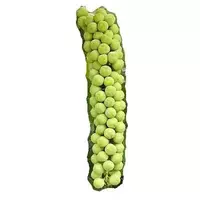Sea grapes (kokkoloba berry-bearing)

Coccoloba uvifera is often called sea grapes due to the fact that in appearance the fruits of the plant really very much resemble clusters of grapes and, moreover, it grows in coastal zones.
In general, sea grapes (coccoloba berry-bearing) are a representative of a species of angiosperm plants. In fact, these are small trees that belong to the Grechishny family. As a rule, sea grapes (coccolobus berry-bearing) are cultivated in South America, as well as along the coastal zone of the Caribbean Sea, Bermuda and Florida.
Basically, sea grapes (berry-bearing coccoloba) differ in height up to two meters, but cases have been recorded when the length of the plant reached eight meters. The leaves of sea grapes (coccoli berry) are characterized by a wide-ovate or oval-round shape, they are quite large - with a width of about 12 centimeters, their length can reach 25 centimeters. The structure of the leaves of sea grapes (coconut berry) is whole-marginal, glossy, durable, almost leathery. They are light green above, and the underside is saturated green.
The flowers of sea grapes (coccoli berry), collected in long brushes, are distinguished by miniature size, cream color and a very pleasant aroma. After they bloom, green round fruits of the same small size form on the clusters. Beneath the purple, woody skin of the fruits of sea grapes (coccoli berries) is a juicy, sweet, marvellous, nutmeg-flavored pulp that envelops a large seed inside.
After ripening, clusters of sea grapes (coccoli of berry) fall - mature berries are consumed not only fresh, but also processed. Basically, they make delicious aromatic jelly. In addition, mature fruits of sea grapes (coccolobs of berry) can be used similarly to ordinary grapes - make wine on their basis, cook compotes and fruit drinks, as well as jam, jams.
As you know, sea grapes (coccoloba berry-bearing) can grow only in tropical climates, therefore, in those places where it is cold and frosts occur, the plant immediately dies. However, a distinctive feature of sea grapes (coccoli berry) is that it is very tolerant of salinization. It is for this reason that the trees are planted close to the shores to stabilize the beaches, as well as for decorative purposes.
In addition, sea grapes (coccoloba berry-bearing) feel good at home, but the plant is best suited for content in a botanical garden. With appropriate care for the tree, its yellowish-green leaflets will be durable and strong, which is almost impossible to achieve under room conditions.
sea grapes (coccoloba berry-bearing) 0 kCal
The energy value of sea grapes (coccoloba berry-bearing) (Ratio of proteins, fats, carbohydrates - ju):
Proteins: 0 g (~ 0 kCal)
Fats: 0 g (~ 0 kCal)
Carbohydrates: 0 g (~ 0 kCal)
 Español
Español Français
Français Português
Português Русский
Русский 简体中文
简体中文 繁體中文
繁體中文 日本語
日本語 한국어
한국어 العربية
العربية Türkçe
Türkçe Қазақ
Қазақ Deutsch
Deutsch Italiano
Italiano Українська
Українська
